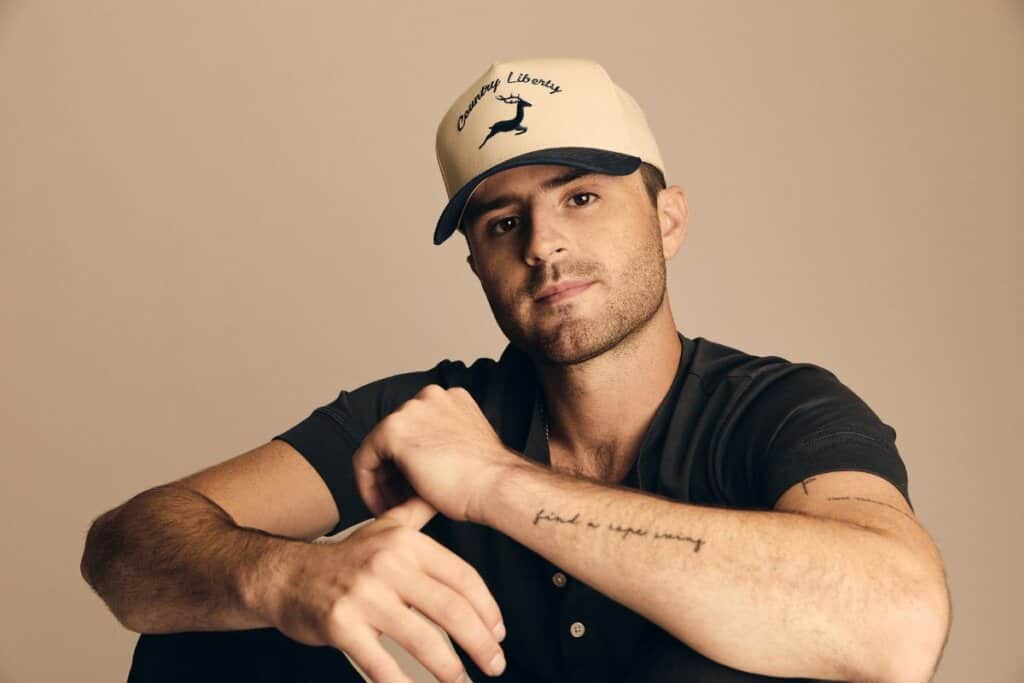- Interviews
- /
- Music
- /
- News
How Justin Moore’s ‘We Didn’t Have Much’ Proves His Staying Power, Even in Unpredictable Times
“I related to it simply because it took me back to my childhood,” Moore shares of his latest chart-topper.

Justin Moore; Photo by Cody Villalobos
As of this week, Justin Moore has ten No. 1 country radio hits under his belt. But although the singer may be old hat on the radio, his newest chart-topper — “We Didn’t Have Much” — has been unlike any other song, ever since he put it out.
The track rose in popularity during strange, tumultuous times. It first came onto the radio back in October of 2020, a time when the COVID-19 pandemic had placed the live music industry firmly under lockdown, with no return to touring yet on the horizon. Moore had chosen to record and release the song long before the pandemic hit; back then, he couldn’t have known what lay ahead. But by the time he sent it to radio, his ode to the simple life had taken on an extra layer of significance, as fans everywhere found themselves hunkered down with family and close friends, trading in travel and bustling schedules for a quieter way of life.
“The ‘simpler lifestyle,’ if you will, took on new meaning, at least to me,” Moore explains to Country Now. “So I think it’s gonna be a song that people look back on and go, ‘Yeah, that song made a lot of sense during that wacky time in 2020.’ But at the same time, I don’t think it’s popular solely because of that.”

Case in point: The song has continued to rise up the charts through the ups and downs of the pandemic, retaining its momentum through spikes, shutdowns, the return of live music, new variants of the virus and more. On Monday (Aug. 23), “We Didn’t Have Much” peaked at No. 1, during a time when the world looked very different back when the song first entered the charts 10 months earlier.
“I think at its simplest, it’s an example [of the fact] that great songs can be relatable in a lot of different situations. It can mean different things to everyone that hears it,” Moore reflects. Back when he first heard it, the song — written by Jeremy Stover, Randy Montana and Paul DiGiovanni — hooked him not for its resonance with modern-day life, but rather for the memories it called to mind.
“I related to it simply because it took me back to my childhood — how I grew up, where I grew up, but probably more so the era in which I grew up,” he adds.
Undoubtedly, that degree of nostalgia contributed to the song’s success. During a year-plus period when the only constants in his fans’ lives have been uncertainty, stress and upheaval, Moore’s brand of traditional-leaning, nostalgia-driven songwriting is nothing short of country music comfort food.
“I might steal that. I like that. It is kinda comfort food, in a way,” Moore laughs, when asked if his steadfast commitment to traditionalism — both in subject matter and style — has taken on new meaning or greater importance over the course of the last couple of years. “I don’t feel as though I’m obligated to fill that role, necessarily. I’m just kinda being who I am, cutting the music that I love and that I relate to, and that I believe other people do as well.
“I love traditional country,” he shrugs. “That’s not a knock against any other kind of country. It’s just what I love doing and what I grew up on. Quite honestly, it’s what I feel like I do better than anything else. So at this stage in my career, I’m not trying to chase any trend out there just to stay on radio. We’ve been there for 14 years now, thanks to country radio.”

That’s not to say that Moore hasn’t focused more on his social media following or looked for virtual ways to connect with fans while he’s been off the road. But he’s done so in ways that feel authentic to him, like starting his own The Justin Moore Podcast, and using that platform to field questions from his followers.
“It’s allowed us to have a pretty cool engagement with fans longform, where we take a lot of questions off social media on there,” the singer explains. The podcast is one quarantine project he thinks he’ll keep during his post-pandemic career, he goes on to say, in part because he had big plans for what it might become even before he had to halt his touring plans.
“We’re certainly going to continue the podcast. You know, when we started it, we weren’t on the road, but we thought we would be shortly thereafter. Obviously, that didn’t come to fruition,” Moore relates. “But our objective with it was to do it from the road, and kind of give some folks some inside baseball: At all these different places we’re playing at, we might run into different artists, and talk to them for 15 minutes or so. Give fans a little bit of a backstage experience. So that’s something that we’ll continue to do now that we’re back on the road.”
When an artist has as solid a musical foundation as Moore does, and is as confident as he is about the music they want to make, experimentation and risk-taking doesn’t necessarily feel scary. The singer knows he’s not the only artist figuring out the best way to return to the road, or the best way to put out all the new music he’s been working on from quarantine. He’s far from the only country singer to have to make the call between putting out a series of EPs and short projects, or one big double or triple album. And though he’s continuing to walk through uncharted territory, Moore doesn’t seem too worried about the future. Just like “We Didn’t Have Much,” he trusts that if he picks great songs, they’ll resonate, no matter what curveball the months ahead might have in store.
For example, he considers his last two albums — Late Nights and Longnecks, which arrived in the summer of 2019, and Straight Outta the Country, which he dropped in April of 2020 — as part of the same musical song cycle. They’re both shorter projects: Late Nights has 10 tracks (or 13, for fans who spring for the deluxe version) and Straight Outta the Country has eight.
“I basically wrote three albums worth of music,” Moore remembers of that time period a few years ago, when he was writing the songs that would become the track lists of both collections. “So we had conversations, like, ‘Do we wanna put it out…all together? Or do we break them up?’ So we chose to do the latter, and I’m glad we did.”
Flash forward a couple of years later, and in the midst of the pandemic, Moore could still give fans a batch of new music they’d never heard before, even if he couldn’t get into the studio to record, because he chose to space out his projects the way he did. Now, in the not-too-distant future, the singer says he’s planning to reveal a third installment — also in the “eight to 12 range” of songs — from that same musical era.
“Again, every artist is doing it differently, and hell, next time we may do it differently. But I’m glad we did this this way,” he points out. “…I think you’ll notice a trend in these three albums, and a continuity between them.”







